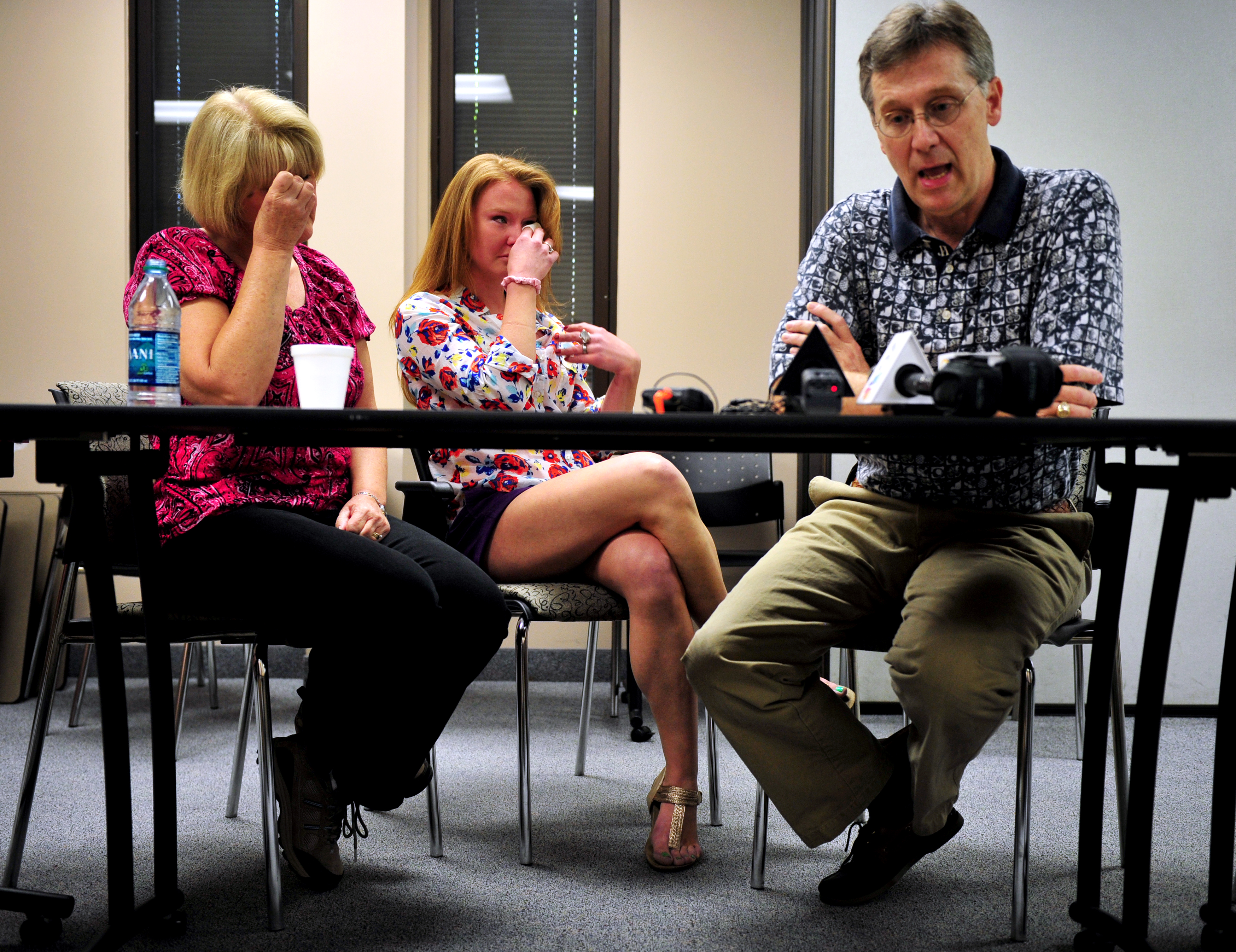Cartersville, Ga., man has 6th surgery for flesh-decaying infection
Thursday, May 24, 2012
 Paige Copeland, center, wipes her eyes as her parents Donna and Andy Copeland speak about their daughter Aimee, Thursday, May 10, 2012, who remains in critical condition at Joseph M. Still Burn Center in Augusta, Ga., after contracting a devastating bacterial infection known as necrotizing fasciitis last week. Doctors say the young woman battling the flesh-decaying bacteria she contracted after a zip line accident will lose her hands and remaining foot to the infection. But Aimee Copeland's father says the 24-year-old college student is improving. (AP Photo/The Augusta Chronicle, Emily Rose Bennett)
Paige Copeland, center, wipes her eyes as her parents Donna and Andy Copeland speak about their daughter Aimee, Thursday, May 10, 2012, who remains in critical condition at Joseph M. Still Burn Center in Augusta, Ga., after contracting a devastating bacterial infection known as necrotizing fasciitis last week. Doctors say the young woman battling the flesh-decaying bacteria she contracted after a zip line accident will lose her hands and remaining foot to the infection. But Aimee Copeland's father says the 24-year-old college student is improving. (AP Photo/The Augusta Chronicle, Emily Rose Bennett)By Fran Jeffries
May 23--A Cartersville man had his sixth surgery Tuesday after contracting the same flesh-decaying bacterial infection as Aimee Copeland.
Bobby Vaughn, 33, is the third person whose infection has come to light in recent weeks in the region.
Vaughn, the owner of a landscaping company, had skin grafts Tuesday to repair areas where his flesh was cut away after he fell ill in early May after getting a small cut on his leg.
He is being treated for necrotizing fasciitis at the same Augusta hospital as Copeland, who nearly died from the infection she contracted after a zip-line injury in Carrollton on May 1. She is improving but remains in critical condition after multiple amputations.
Vaughn, a landscaper, has been in the hospital since May 4. He said he fell ill after getting a "very small cut on his leg" near his groin area while trimming weeds.
Later that day, "I started dry heaving and throwing up" and had a backache and felt weak, he said in a phone interview with the AJC from his hospital bed Monday.
The next day, when the cut began to swell, Vaughn said he went to Cartersville Medical Center. "I could hardly move; I was in a lot of pain," he said.
The hospital gave him antibiotics and asked to admit him for observation, but "being the man that I am," Vaughn refused.
He went home, and the bump got bigger and bigger. "It went from a peanut (size) to grapefruit (size) and larger," he said.
The next day, Vaughn went back to the hospital and asked to be admitted. Doctors took him directly to surgery, "it was that bad. They told me I was close to death," he said.
Doctors removed some dead tissue at the Cartersville hospital, then sent Vaughn to Joseph M. Still Burn Center in Augusta. More than two pounds of tissue were removed over five surgeries to stay ahead of the infection, Vaughn said.
On Tuesday, Vaughn had skin grafts to repair areas where his flesh was cut away. "They have to rebuild my groin area," he said. "But I'm feeling much better now."
At one point, Vaughn's room was next door to that of Copeland, 24, of Snellville. She was hurt when she cut her calf on a homemade zip-line that broke and plunged her onto rocks in the Little Tallapoosa River near Carrollton.
The bacteria entered through Copeland's wound, forcing doctors to amputate her left leg at the hip.
Copeland's hands were amputated Thursday because they had turned purple and were threatening her recovery. "It's almost like she had poison bags on the end of her arms," her father Andy Copeland told the Associated Press.
Copeland is improving and is now breathing on her own after having been on a breathing tube until Wednesday, her father wrote in a Facebook post. Copeland had been given little chance of survival earlier in her prognosis.
In a third case, Lana Kuykendall, of Greenville, S.C., is being treated for necrotitis faciitis after giving birth to twins in Atlanta. Her brother, Brian Swaffer, told media outlets Sunday afternoon that while she is still in critical condition in a Greenville hospital, she is stabilized.
"She has a very long road ahead of her," Swaffer told the Greenville (S.C.) News. "She has undergone seven surgeries. We are thankful that the infection has been contained to just her legs and has not spread anywhere else."
Doctors insist there is no link or common cause among the victims.
Aeromonas hydrophila, the bacteria that led to the infection in Copeland's case, is typically found in warm climates and waters. The bacteria is "ubiquitous," Dr. Jay Varkey, an epidemiologist in the Division of Infectious Diseases at the Emory University School of Medicine, told the AJC.
Most people encounter it and suffer no illness, while others might contract a stomach bug or a minor skin infection, he said. The most serious side effects typically happen to people with weakened immune systems.
The Augusta hospital provides the best wound care in the United States, so it is not uncommon for it to receive patients with the infection, said hospital spokeswoman Barclay Bishop.
"Last year, of all of our wound-care patients, 8.5 percent of them suffered from necrotizing fasciitis," Bishop said.
Thirty-three of those patients were from Georgia; seven, from South Carolina, and one each, from Alabama and Florida, Bishop said. The average age of patients suffering from the disease was 52, she said.
